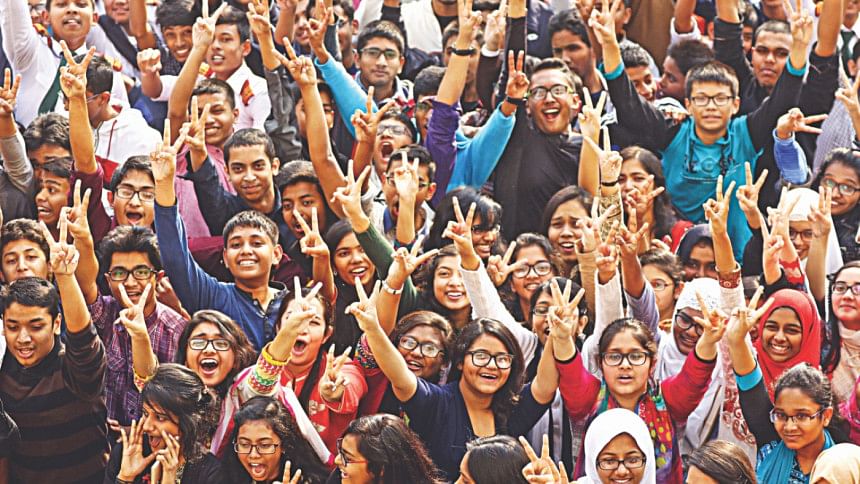Junior school exams

Class-VIII students have done better than ever in Junior School Certificate (JSC) examination, taking the success rate to a new height.
With more students achieving the highest grade, the pass rate hit a record high of 92.31 percent, 2.46 percentage points higher than that of 2014.
A total of 1,87,502 students under eight general education boards across the country secured GPA-5 in the test for 2015, up by 50,557 in 2014, according to the results published yesterday.
Students took the test that started on November 1.
They have consistently been doing well in the exam since its introduction in 2010, when the pass rate was 71.34 percent. A steady uptrend has been marked in the results over the last six years.
This time, girls outshone boys in terms of pass rate and GPA-5 (Grade Point Average) achievers.
Officials and teachers attributed the success to students' better performance in maths.
In 2014, students could not perform well in maths as the government introduced the creative system in the subject for the first time without giving students proper time to get used to it, they said.
Teachers were also not given adequate training on the new system, causing a decline in the number of GPA-5 holders, they added.
“But this year [2015], we put more focus on this subject. We've given massive training to mathematics teachers on the new system, which we could not do last year [2014],” said Education Minister Nurul Islam Nahid.
“The teachers taught students maths in a better way and the students learned it well and thus fared better,” he told reporters while formally announcing the results at a press conference at his ministry around 1:30am.
The statistics provided by the education boards tell the same thing.

The pass rate in mathematics in Dhaka Board rose to 96.24 percent from 89.40 in 2014. In Chittagong Board, the rate jumped up by 5.35 percent to 93.77 percent.
On an average, the success rate in this subject increased by 3 percent over 2014.
“Generally, it's either English or mathematics that makes the difference in the results. And the students have done well in mathematics, as we have been able to make them understand the new system well,” said a teacher of a city school.
Apart from this factor, the education minister attributed the success to the combined effort of all.
He said better care by the teachers and guardians, competitiveness of students and their awareness contributed to this feat.
Free and on-time textbook distribution, showing videos of lectures of best teachers at schools, and use of technology in imparting lessons made it possible, he said while briefing journalists.
The results of all education boards, published simultaneously after the briefing, brought smiles to more than one million students who were living on their nerves for the last couple of days. The schools also wore a festive look following the publication of the results.
The students got their results from their respective schools, on website (www.educationboardresults.gov.bd) and through text messages.
“Finally, my dream came true. This result inspires me to do better in future,” said Tamzid Hasan, a JSC examinee, who got GPA-5.
For the first time, there was no top chart of best schools, as the government stopped preparing the list of the best institutions saying that it created an “unhealthy competition” among schools.
Before the announcement of the results, the education minister handed over a copy of the results to Prime Minister Sheikh Hasina at Gono Bhaban yesterday morning.

The results showed a significant improvement in all other indicators.
The number of total examinees and number of schools with cent percent pass rate rose from those in 2014, while the number of schools with zero pass rate remained static.
A total of 17,80,770 students -- 9,49,838 girls and 8,30,932 boys -- under eight general education boards came out successful in the JSC exam in 2015. Some 1,48,329 students flunked. Some 19.29 lakh class-VIII students took the test.
And 548 out of 558 JSC students, who sat for the test in eight overseas centres, came out successful. Of them, 111 obtained GPA-5.
The pass rate in Junior Dakhil Certificate (JDC) examinations is 92.46 percent.
The combined pass rate of JSC and JDC in eight general boards and one madrasa board beat previous records with 92.33 percent students coming out successful. In 2014, the pass rate was 90.41 percent.
The highest number of examinees, 97.47 percent, passed from Rajshahi Board. Chittagong Board is at the bottom among the eight boards with 85.48 percent pass rate. Dhaka Board secured seventh position with 90.39 percent pass rate.
Girls have beaten boys at the top level. Of the total GPA-5 scorers under nine boards, 1,11,303 are girls and 84,960 are boys. The pass rates of girls and boys are 92.44 and 92.24 percent respectively.

 For all latest news, follow The Daily Star's Google News channel.
For all latest news, follow The Daily Star's Google News channel. 








Comments